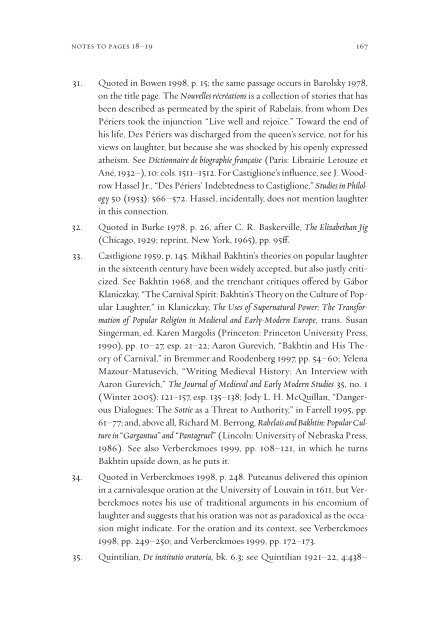Pieter Bruegel and the Art of Laughter - AAAARG.ORG
Pieter Bruegel and the Art of Laughter - AAAARG.ORG
Pieter Bruegel and the Art of Laughter - AAAARG.ORG
Create successful ePaper yourself
Turn your PDF publications into a flip-book with our unique Google optimized e-Paper software.
notes to pages 18–19 167<br />
31. Quoted in Bowen 1998, p. 15; <strong>the</strong> same passage occurs in Barolsky 1978,<br />
on <strong>the</strong> title page. The Nouvelles récréations is a collection <strong>of</strong> stories that has<br />
been described as permeated by <strong>the</strong> spirit <strong>of</strong> Rabelais, from whom Des<br />
Périers took <strong>the</strong> injunction “Live well <strong>and</strong> rejoice.” Toward <strong>the</strong> end <strong>of</strong><br />
his life, Des Périers was discharged from <strong>the</strong> queen’s service, not for his<br />
views on laughter, but because she was shocked by his openly expressed<br />
a<strong>the</strong>ism. See Dictionnaire de biographie française (Paris: Librairie Letouze et<br />
Ané, 1932–), 10: cols. 1511–1512. For Castiglione’s influence, see J. Woodrow<br />
Hassel Jr., “Des Périers’ Indebtedness to Castiglione,” Studies in Philology<br />
50 (1953): 566–572. Hassel, incidentally, does not mention laughter<br />
in this connection.<br />
32. Quoted in Burke 1978, p. 26, after C. R. Baskerville, The Elizabethan Jig<br />
(Chicago, 1929; reprint, New York, 1965), pp. 95ª.<br />
33. Castligione 1959, p. 145. Mikhail Bakhtin’s <strong>the</strong>ories on popular laughter<br />
in <strong>the</strong> sixteenth century have been widely accepted, but also justly criticized.<br />
See Bakhtin 1968, <strong>and</strong> <strong>the</strong> trenchant critiques oªered by Gábor<br />
Klaniczkay, “The Carnival Spirit: Bakhtin’s Theory on <strong>the</strong> Culture <strong>of</strong> Popular<br />
<strong>Laughter</strong>,” in Klaniczkay, The Uses <strong>of</strong> Supernatural Power: The Transformation<br />
<strong>of</strong> Popular Religion in Medieval <strong>and</strong> Early-Modern Europe, trans. Susan<br />
Singerman, ed. Karen Margolis (Princeton: Princeton University Press,<br />
1990), pp. 10–27, esp. 21–22; Aaron Gurevich, “Bakhtin <strong>and</strong> His Theory<br />
<strong>of</strong> Carnival,” in Bremmer <strong>and</strong> Roodenberg 1997, pp. 54–60; Yelena<br />
Mazour-Matusevich, “Writing Medieval History: An Interview with<br />
Aaron Gurevich,” The Journal <strong>of</strong> Medieval <strong>and</strong> Early Modern Studies 35, no. 1<br />
(Winter 2005): 121–157, esp. 135–138; Jody L. H. McQuillan, “Dangerous<br />
Dialogues: The Sottie as a Threat to Authority,” in Farrell 1995, pp.<br />
61–77; <strong>and</strong>, above all, Richard M. Berrong, Rabelais <strong>and</strong> Bakhtin: Popular Culture<br />
in “Gargantua” <strong>and</strong> “Pantagruel” (Lincoln: University <strong>of</strong> Nebraska Press,<br />
1986 ). See also Verberckmoes 1999, pp. 108–121, in which he turns<br />
Bakhtin upside down, as he puts it.<br />
34. Quoted in Verberckmoes 1998, p. 248. Puteanus delivered this opinion<br />
in a carnivalesque oration at <strong>the</strong> University <strong>of</strong> Louvain in 1611, but Verberckmoes<br />
notes his use <strong>of</strong> traditional arguments in his encomium <strong>of</strong><br />
laughter <strong>and</strong> suggests that his oration was not as paradoxical as <strong>the</strong> occasion<br />
might indicate. For <strong>the</strong> oration <strong>and</strong> its context, see Verberckmoes<br />
1998, pp. 249–250; <strong>and</strong> Verberckmoes 1999, pp. 172–173.<br />
35. Quintilian, De institutio oratoria, bk. 6.3; see Quintilian 1921–22, 4:438–












